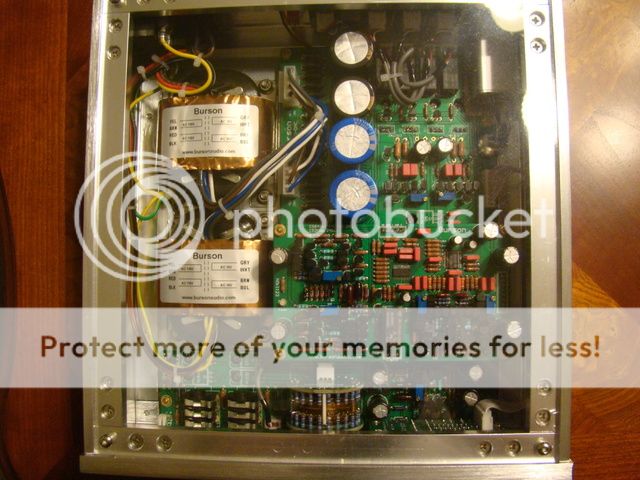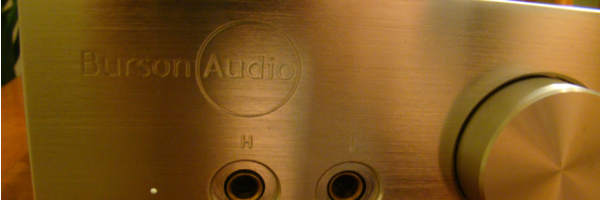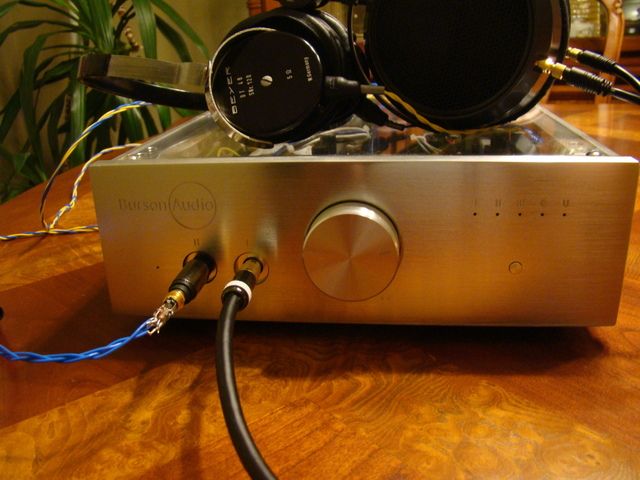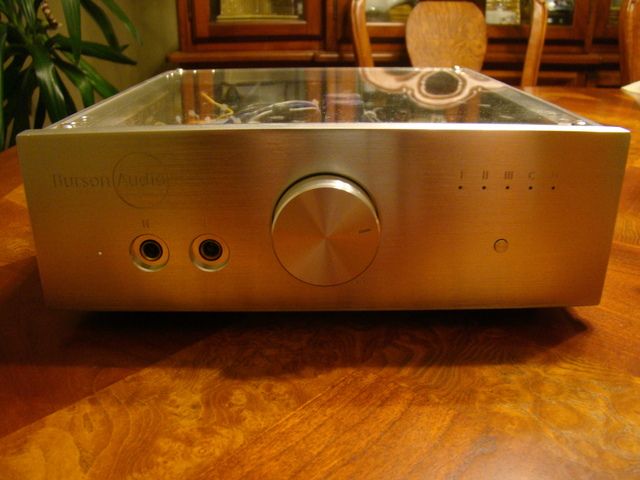Amplifiers are kind of grey area in the headphone world. They’re obviously necessary, since headphones need sufficient power to truly sing, but at what price point does the phrase “diminishing returns” kick in at its fullest? It’s been said that cables are the ultimate representative of this, mostly because the question of if cables actually prove a tangible difference even exists. Different DACs are at least measurably better than others, so proof can be found, no matter how miniscule the actual difference is. Amplifiers, in my opinion, are second in line for quickest diminishing returns after the cables and DAC. It is quite easy to obtain a wonderful amplifier by buying a vintage receiver, which seems to be all the rage as of late, but how does a vintage amplifier compare to the crème de la crème of Burson Audio’s HA-160D? Well, all that will come later. First I must sing my praises for the truly awesome product Burson’s created.
Before I say anything else, I must heartily thank Burson for allowing me to borrow the HA160D for much longer than anticipated due to some funky circumstances. They have the most patient CS representative I’ve come across, especially since I have a piece of $1,100 gear just sitting an ocean away, and simply for that, I praise Burson as a company.
(Paraphrased from their website) Burson is an Aussie audio company started by Mark Burson, who was a passionate audiophile that worked in the recording industry for over thirty years and spent his free time working on amps. Suffice to say, he probably knows his stuff. Team Burson worked on making cost-no-object amplifiers to make the best dang amplifiers Melbourne had been graced with, and finally released their first product in 2005.

The Burson HA160D is Burson’s TOTL headphone amp, and it certainly shows. It’s fully decked out with USB DAC, preamp capabilities, high AND low gain headphone outputs – especially useful when trying to use a high and low impedance headphone at the same time 24 stepped volume control to turn it WAY past 11 (:P), a big honkin’ solid aluminium housing, and much more to make for a (roughly) 14 pound amp!
During my run through, I primarily used it as a DAC/amp combo, so I’ll base my findings on that to begin with. The headphones I used were the Hifiman HE500, AKG K240DF, Beyerdynamic DT220, Beyerdynamic DT48, Realistic Pro 50 (it’s kind of like an OEM’ed AKG K240 Sextett), Koss Technician VFR, Audio Technica ATH-2, and Monster Turbine Pro Gold. To be honest, I’ve always been skeptical about major difference between capable amplifiers. This proved to me that the differences are more pronounced than I figured they would be. While the ideal amplifier is a “wire with gain” affair, I tend to love the warm presentation vintage amplifiers tend to give, so I’m biased towards that.
The amplifier is tuned to present the mids slightly forward, which I quite like. Vocals and instruments were given some extra shimmer and realism. Female vocals absolutely shone with the HA160D with the extra fullness given. The same effect is shown with male vocals and their added lushness. Treble is the slightest bit subdued, which isn’t necessarily a bad thing with these modern headphones emphasizing treble just a bit too much to convey extra detail that audiophiles crave so very much. Bass is pretty awesome. It’s tight and joyously quick and livens the sound up to an amazing degree.
I could never quite understand how a source of any kind can increase soundstage, and the Burson still doesn’t truly help, but I will say that it adds some spaciousness and makes positioning much more pinpoint.
Since I’m basically all out of words for how the amp sounds in general, I figured that I’d make some comparisons to my Harman Kardon HK430 (A fine receiver in its day) connected to an EMU 0204 as a DAC. It’s not the best setup, but it all cost around $120 combined. So how does the HA160D, at 85% more, compare? Well, put simply, it’s disturbingly close, depending on the headphone. I’ll put some short blurbs about the headphones I tested.
Hifiman HE500
The HE500’s, a somewhat sensitive isodynamic headphone, really like the Burson. Their somewhat heightened treble is countered by the slightly subdued treble and the mids are even more intimate, which was utterly spectacular with Diana Krall. The HK430 had the upper hand in absolute power, but was left in the dust. It’s just too warm for the HE500 and takes away its top-tier qualities. The only thing I liked better about it was the more visceral punch it gave to the planars. But to be frank, I don’t think either pushed the HE500 to its best.
Beyerdynamic DT48
For some reason, the DT48 sounds terrible on the Burson, even with the 120ohm impedance adapter that’s arguably necessary for the 5ohm beasts. They sounded totally flat and lifeless, which is just a matter of poor amp matching. The DT48’s need as warm of an amp as possible, which the HK430 can start to give. I’m not really going to go into detail here, but with a warm amp, the DT48’s can kind of live up to the hype.
Realistic Pro 50
I’m just going to be frank here. The Burson’s pretty much perfect. If the RP50 was more resolving, I’d be thinking about buying a Burson of my own just for this pairing. I’ve never heard better brass, not even from the HE500 or DT48. Just perfect. I didn’t even want to directly compare it to the HK430 because I know the old thing doesn’t even come close.
Audio Technica ATH-2
These rather maligned headphones are some rockin’ experiment of the 70’s by Audio Technica with a 32ohm Sawafuji planar magnetic driver. They need a good bit of power to perform at their best in my opinion. The Burson gives some additional warmth that was not exactly needed and sucks out some of the upper mids that I liked, leaving them kind of lifeless. Details were much more prevalent with the Burson. Despite the lifeless sound, they still sounded nicer with the Burson than the too-warm Harman concoction. I think I have some more experimenting to do with these headphones if I want to use them with a treble-light amp.
Koss Technician VFR
The Technician VFR’s are my quirkiest headphones. There’s pretty much no information about them, so I’m just going to make some guesses. They’re probably a low impedance (16-32ohm) headphone with average sensitivity. They’ve a very bass heavy headphone (after I refurbished them) that’s underwhelming everywhere else. The HK430 pretty much makes them unlistenable. The amp’s so dang warm that I can’t go through an entire song without feeling nauseous. The Burson makes them slightly more listenable by controlling the epic bass and adding a bit of midrange. They still aren’t as good as with a bright amplifier.
Beyerdynamic DT220
This is a somewhat flat headphone that doesn’t do too much wrong and is pretty sensitive, but greatly improves with power. The Burson is just about perfect for this headphone, taming the slightly bright treble, giving the ever-so-slightly subdued bass some extra punch and quickness, and added some intimacy to the already forward midrange. Just about perfect, but there’s the slightest bit of recession in the lower midrange. The HK430 gave just a bit too much bass to the DT220 to the point where I heard some sloppiness.
Basically, what can be deduced from this experiment is that the Burson is more than powerful enough for most headphones, so the question is, “Will this match my headphones?” Well, the Burson errs on the warm side with forward mids, so basically, a very slightly bright headphone would make an aurgasmic match with the Burson. A dark headphone might work decently too, but be prepared for some bass.
The DAC in the Burson is very capable. It decimated the EMU, which was always just a bit too bright for my tastes and was scarily digital sounding, whereas the Burson sounds almost musical.
So where do we stand? Well, Burson has made a wonderful product in the HA160D. $1,100 may be hard to swallow for most, but considering this is an all in one box with both a capable DAC and a “safe” sounding but very good amp, $1,100 might not be too big of a pill to swallow for those that have found their perfect headphone and want to bring it to the next level.





